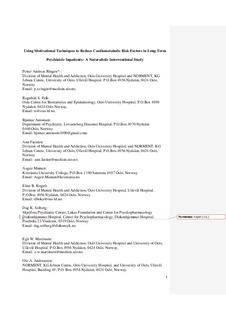| dc.description.abstract | Background
People with severe mental illness have markedly reduced life expectancy; cardiometabolic disease is a major cause. Psychiatric hospital inpatients have elevated levels of cardiometabolic risk factors and are to a high degree dependent of the routines and facilities of the institutions. Studies of lifestyle interventions to reduce cardiometabolic risk in psychiatric inpatients are few. The current study aimed at assessing the feasibility and effects of a lifestyle intervention including Motivational Interviewing (MI) on physical activity levels, cardiometabolic risk status and mental health status in psychotic disorder inpatients.
Methods
Prospective naturalistic intervention study of 83 patients at long term inpatient psychosis treatment wards in South-Eastern Norway. Patients were assessed 3–6 months prior to, at start and 6 months after a life-style intervention program including training of staff in MI, simple changes in routines and improvements of facilities for physical exercise. Assessments were done by clinical staff and included level of physical activity, motivation, life satisfaction, symptom levels (MADRS, AES-C, PANSS, and GAF) as well as anthropometric and biochemical markers of cardiometabolic risk. A mixed model was applied to analyze change over time.
Results
A total of 88% of patients received MI interventions, with a mean of 2.5 MI interventions per week per patient. The physical activity level was not increased, but activity level was positively associated with motivation and negatively associated with positive symptoms. Triglyceride levels and number of smokers were significantly reduced and a significant decrease in symptom levels was observed.
Conclusions
The current results suggest that a simple, low cost life-style intervention program focusing on motivational change is feasible and may reduce symptoms and improve lifestyle habits in psychosis patients in long term treatment facilities. Similar programs may easily be implemented in other psychiatric hospitals. | nb_NO |

